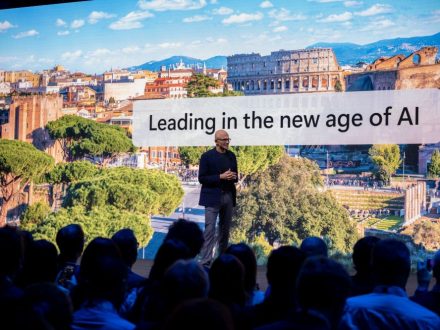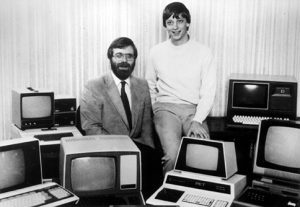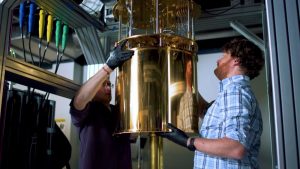Microsoft’s 50th Anniversary: Half a Century of Bringing Technology to Homes and Businesses

Microsoft was born with the dream of putting a computer in every home. With that goal more than achieved, the company now wants to do the same with AI.
Microsoft was launched on 5 April 1975, when Bill Gates and Paul Allen, friends since childhood, got together in a garage with the aim of ‘putting a computer on every desk and in every home’, as they have explained on more than one occasion.
Fifty years later, that goal is more than achieved. And Microsoft is largely responsible for it.
The company is a giant with around 230,000 employees and a turnover of around 250 billion dollars (245.1 billion in the 2023-2024 financial year, which closed on 30 July), as we reported on Silicon.es.
The path that has led the company this far has not been without obstacles, but Microsoft has been able to overcome them and adapt to the needs of the market. Perhaps not as quickly as many claimed, but this calmness when it comes to making important decisions has helped the company to walk on the safe side.
‘Fifty years ago, Bill [Gates] and Paul [Allen] founded Microsoft with a simple but powerful idea: to develop technology so that people around the world could develop more technology. The first product Microsoft created was the Basic interpreter for Altair, which gave people the power to create software, drove the PC revolution and created a whole new industry for our economy,’ explained Satya Nadella, the company’s CEO, at the 50th anniversary celebrations.

Top 5 Microsoft milestones
Microsoft’s achievements in its half-century history have been many. ‘Over the past five decades, we have driven technological innovation, transforming the way people work and live. From revolutionising personal computing with MS-DOS and Windows, to redefining the gaming experience with Xbox and leading cloud computing with Azure, we have evolved to stay ahead of the curve,’ says Carolina Castillo, Director of Operations and Marketing at Microsoft Spain.
We don’t want to just list these achievements, but we do want to highlight the key milestones with which Microsoft has made a decisive contribution to the evolution of the technology sector.
Launch of MS-DOS and Windows
‘In 1981, we took a decisive step in the industry by entering the operating system business with MS-DOS, which became the standard when it was incorporated into the first IBM PCs. Four years later, we introduced Windows, our graphical interface that allowed users to run multiple programs simultaneously and laid the foundation for modern computing,’ says Castillo.
This not only brought about a radical change in personal computing, but also marked the beginning of Microsoft’s dominance in the operating system market. In addition, Windows revolutionised the way we interact with computers, with a graphical interface that made them more accessible to non-technical users.
The evolution: Windows 95
‘In 1995, the launch of Windows 95 marked a turning point in personal computing. We introduced the task bar, the start button and the ‘plug and play’ functionality, which made hardware installation much easier’, says the Director of Operations and Marketing at Microsoft Spain.

Microsoft also foresaw that the future was on the internet, when there were hardly any users connected to the net. Thus, Internet Explorer was launched that same year, as part of the add-on package Plus!
Xbox: a new entry into entertainment
‘In 2001, we decided to take a big leap into the entertainment industry with the Xbox launch, our first video game console. With unprecedented graphics and audio capabilities, we set a new industry standard and inaugurated the gaming ecosystem that today includes Xbox Live, Game Pass and next-generation consoles like Xbox X | S Series,’ he says.
The company came into this arena when the gaming industry was fully established, but has adapted to new consumer trends.

Azure: leap into the cloud
Microsoft launched Azure in 2010, 6 years after Amazon Web Services (AWS). Here too it was not the fastest, but its strategy has been very successful, taking a 20% market share, behind AWS (30%), but ahead of Google Cloud Platform, according to data from HG Insights.
‘In 2010, we took our vision to the cloud with Azure, which became a strategic pillar of Microsoft. Today, Azure is one of the leading cloud platforms in the market, driving innovations in artificial intelligence (AI), big data and security, and enabling businesses and developers around the world to create scalable and secure solutions,’ Castillo notes.
Copilot: the breakthrough in generative AI
‘We have led the digital transformation with the integration of AI into our products. With the launch of Microsoft Copilot, we have brought generative AI to key tools such as Microsoft 365, Dynamics 365, Windows 11, as well as the new category of our PCs, Copilot+ PC,’ explains the head of Microsoft.
In this way, Microsoft is using Copilot to make AI accessible, easy to use and useful for everyone in their daily lives.
This is how its business is divided up
In the last quarter, Microsoft posted revenue of $69.6 billion, ‘12% more than in the same period last year,’ Castillo said. ‘In particular, Microsoft Cloud continued to grow strongly, with revenue up 21%, driven by growing demand for services such as Azure, which saw a 31% increase,’ he adds.
‘Breaking down our main business areas, Productivity and Business Processes, which encompasses Microsoft 365, Dynamics and LinkedIn, generated $29.4 billion, representing 42% of our revenue, up 14%. Intelligent Cloud reached $25.5 billion, up 19%, representing 37% of the total. Finally, More Personal Computing, which includes Windows, Xbox and devices, contributed the remaining 21%.
Strong commitment to Spain and sustainability
Castillo points out that Microsoft is focused on consolidating and expanding its operations globally. The strategy deployed in Spain is a clear example of this.
Last year the company presented Spain Central, its new cloud region in Madrid, as we reported at the time. And just a few weeks ago we learned that it is going to build Spain North, its new region in our country, which will be built in Aragon and will be ‘one of the largest in Europe’, according to Paco Salcedo, the new president of Microsoft Spain.

‘We have recently announced an investment in Aragon in the coming years that could exceed 10,000 million euros. This investment joins the one made for the launch of our cloud region Spain Central, located in the Community of Madrid, from which we are already providing AI and cloud services and solutions to our customers in Spain,’ says the director of Operations and Marketing of Microsoft Spain.
‘For Spanish companies and public entities, this means that customers will have the best cloud technology, with lower latency and all the guarantees of security, privacy and data sovereignty,’ she adds.
As he explains, Microsoft has chosen Spain as a priority country to deploy AI and cloud infrastructures ‘because of the excellent quality of telecommunications infrastructures in the country, as well as the high availability of renewable energy, which is fundamental to our sustainability commitments’.
‘As a company, we aim to be carbon negative by 2030 and to eliminate the company’s historical CO2 footprint by 2050. Our commitment to sustainability and efficiency is unquestionable. In this regard, we have recently announced that the new data centres we will build in Spain will not consume water for cooling. We will use a closed-loop cooling technology that also allows cooling at server and even chip level. This makes cooling much more efficient,’ he explains.
Roadmap for another 50 years
In addition to the expansion of its operations in Spain, there are many other challenges on Microsoft’s roadmap. ‘The first thing we always do is to look back and reflect on where we have come from. In these 50 years, there has been one constant: change and the ability to adapt. We have learned that, to stay where we are, it is essential to be able to change, to understand the market, to be flexible, to listen and to have a DNA focused on democratising technology. Our initial mission was to bring a computer with Microsoft software to every business and home. Today, our mission is to empower every organisation and every person on the planet to achieve more,’ she explains.
And this evolution will include advances in AI development, quantum computing, cybersecurity and bridging the digital divide.
‘I believe that in the next few years we will see the adoption of the AI revolution and its penetration into all layers of society. There will be a phase of adoption of this technology and value creation around it. If we look even further ahead, the next big step will be quantum computing, and we are very active in that field, with a large research team and the recent announcement of Majorana 1, the world’s first quantum processor powered by topological qubits,’ says Castillo.

In this sense, he is very optimistic about the future of our country. ‘We are in a favourable situation with AI and I see great potential to boost the country’s growth. AI is a general-purpose technology, and the real value is not only in those who develop it, but in those who best apply it. Spain will have one of the best cloud and AI infrastructures in Europe and has a unique opportunity to increase productivity, improve competitiveness, optimise public services and overcome social challenges,’ he stresses.
On the other hand, he insists that cybersecurity is one of the most important challenges we will have to face in the coming years. ‘AI relies on data, and without the right data structure, it cannot deliver the expected performance. It is therefore crucial to accelerate the modernisation of our applications and data architectures, while strengthening cybersecurity policies,’ he stresses.
Finally, he stresses the need to reduce the digital divide. ‘Despite the fact that Spain is the fourth European country in the use of AI, it ranks 14th in terms of the availability of talent with the necessary skills,’ he says.
In response to this, he recalls that Microsoft has just launched an initiative to train one million people in Spain this year in AI skills for free. ‘Through partnerships with educational institutions, regional governments, businesses and foundations, we seek to ensure that everyone has access to the training they need to thrive in the digital age,’ he notes.
‘We know that today’s success does not guarantee tomorrow’s success, and in that learning capacity, which is part of our culture, we will try to remain true to who we have been and who we are today. With that compass, we will try to navigate the next 50 years,’ Castillo concludes.